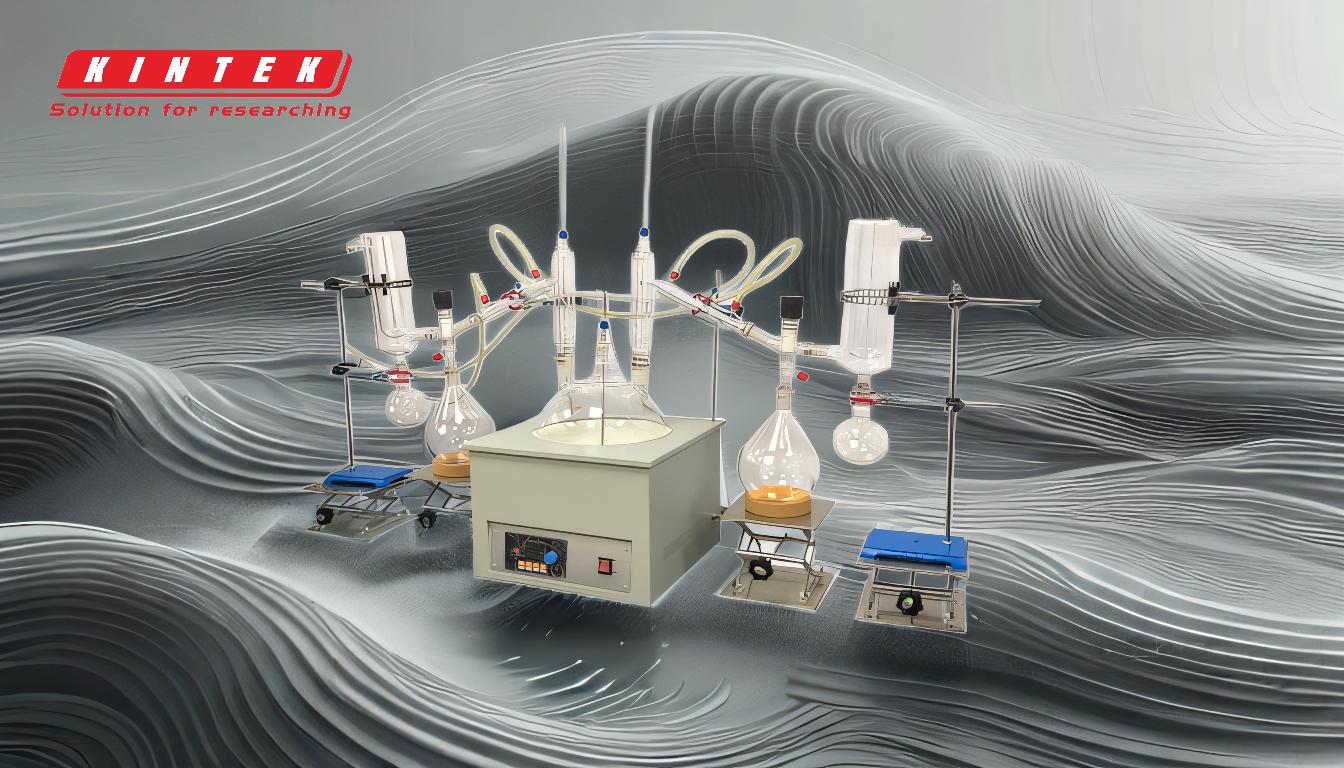Short path distillation is a specialized technique used to separate and purify compounds based on their boiling points under reduced pressure. This process is particularly useful for heat-sensitive materials, as it minimizes thermal degradation. The method involves heating a mixture in a flask under vacuum, causing components to evaporate at lower temperatures. The vapors travel a short distance to a condenser, where they are cooled and condensed back into liquid form. The condensed fractions are collected in separate flasks based on their weight and volatility. This process is highly efficient, compact, and ideal for laboratory applications requiring precise separation of complex mixtures.
Key Points Explained:

-
Reduction of Pressure to Lower Boiling Points:
- Short path distillation operates under high-vacuum conditions, significantly reducing the pressure inside the system. This reduction in pressure lowers the boiling points of the substances, allowing them to evaporate at much lower temperatures than they would under normal atmospheric conditions. This is particularly beneficial for heat-sensitive compounds that might degrade at higher temperatures.
-
Heating and Evaporation:
- The mixture to be distilled is placed in an evaporating flask, which is then heated using a heating mantle. The temperature is gradually increased to pre-determined levels, causing the different components of the mixture to evaporate at their respective boiling points. A magnetic stirrer is often used to ensure uniform heating and to prevent localized overheating.
-
Short Distance Travel of Vapors:
- The term "short path" refers to the minimal distance that the vapors travel from the evaporation surface to the condensation surface. This short travel distance, often just a few centimeters, minimizes the risk of contamination and loss of material. It also makes the process more efficient and suitable for small-scale laboratory applications.
-
Condensation and Collection:
- The evaporated vapors travel through a fractionating tube and enter a condensing unit, where they are cooled and condensed back into liquid form. This is typically achieved using a recirculating chiller that cools the condensing coil. The condensed liquids are then collected in separate receiving flasks based on their weight and volatility. This allows for the precise separation of different fractions from the original mixture.
-
Fractional Separation:
- The process of short path distillation is often referred to as fractional distillation because it separates the mixture into distinct fractions based on their boiling points. Each fraction is collected in a separate flask, allowing chemists to isolate and consolidate multiple desirable elements from a single sample. This is particularly useful in the purification of complex mixtures like crude oil or cannabinoid extracts.
-
Repeatability and Refinement:
- The process can be repeated multiple times to achieve optimum separation and refinement of the desired compounds. Each cycle of distillation further purifies the fractions, making it possible to isolate high-purity compounds from complex mixtures.
-
Advantages of Short Path Distillation:
- Compact and Efficient: The short travel distance of vapors makes the apparatus compact and suitable for laboratory settings with limited space.
- Minimal Thermal Degradation: The reduced pressure and lower boiling points minimize the risk of thermal degradation, making it ideal for heat-sensitive materials.
- High Purity: The ability to separate and collect distinct fractions allows for the isolation of high-purity compounds.
- Versatility: The method can be applied to a wide range of materials, including essential oils, cannabinoids, and other complex mixtures.
By following these steps, short path distillation provides a highly effective method for separating and purifying compounds, making it an invaluable tool in both research and industrial applications.
Summary Table:
| Key Aspect | Description |
|---|---|
| Pressure Reduction | Lowers boiling points, ideal for heat-sensitive compounds. |
| Heating & Evaporation | Uniform heating with magnetic stirrer prevents overheating. |
| Short Vapor Travel | Minimizes contamination and material loss, enhancing efficiency. |
| Condensation & Collection | Vapors are cooled and collected in separate flasks based on volatility. |
| Fractional Separation | Separates mixtures into distinct fractions for high-purity isolation. |
| Repeatability | Multiple cycles refine and purify compounds further. |
| Advantages | Compact, efficient, minimal thermal degradation, high purity, and versatile. |
Discover how short path distillation can optimize your lab processes—contact us today for expert guidance!











